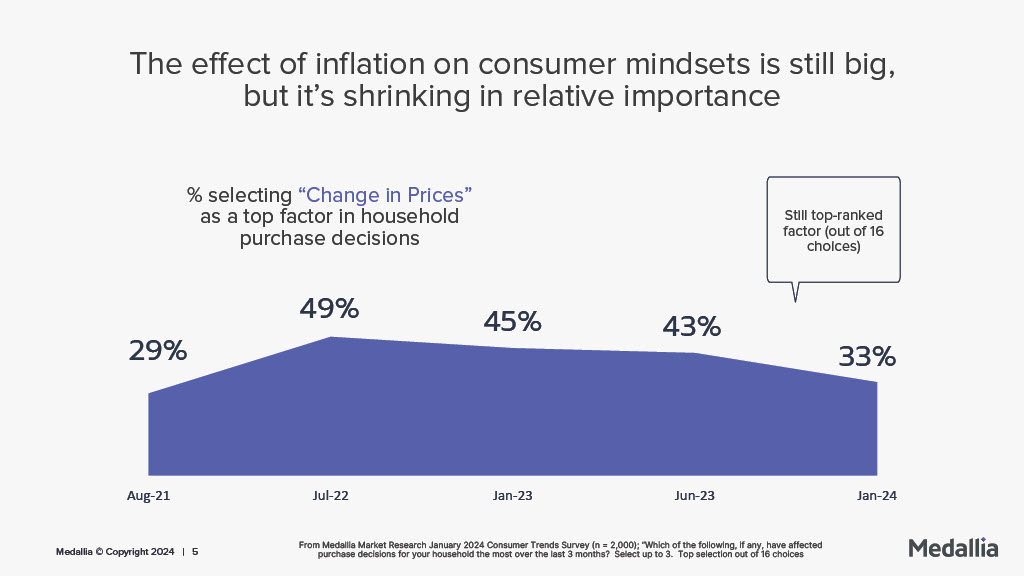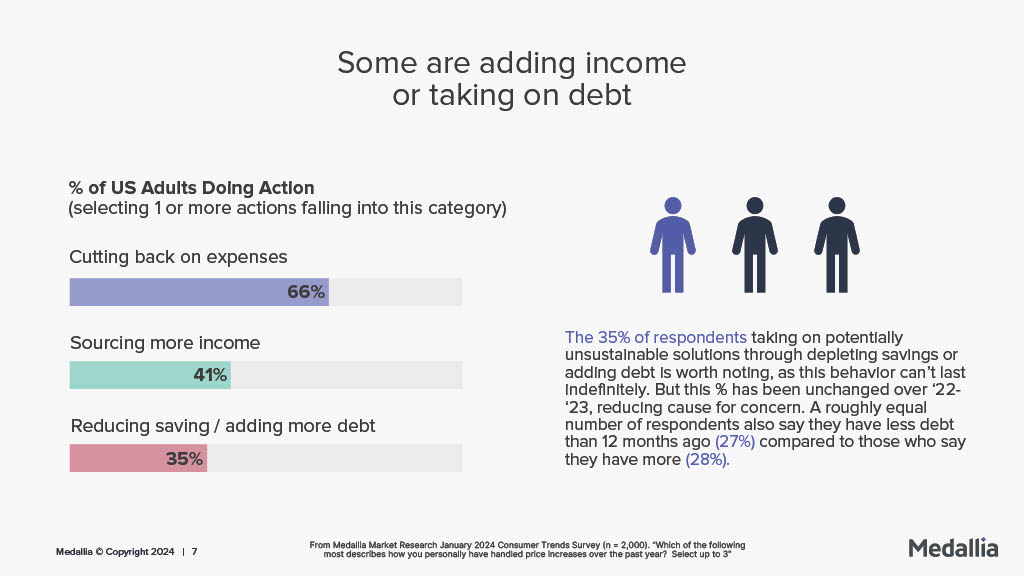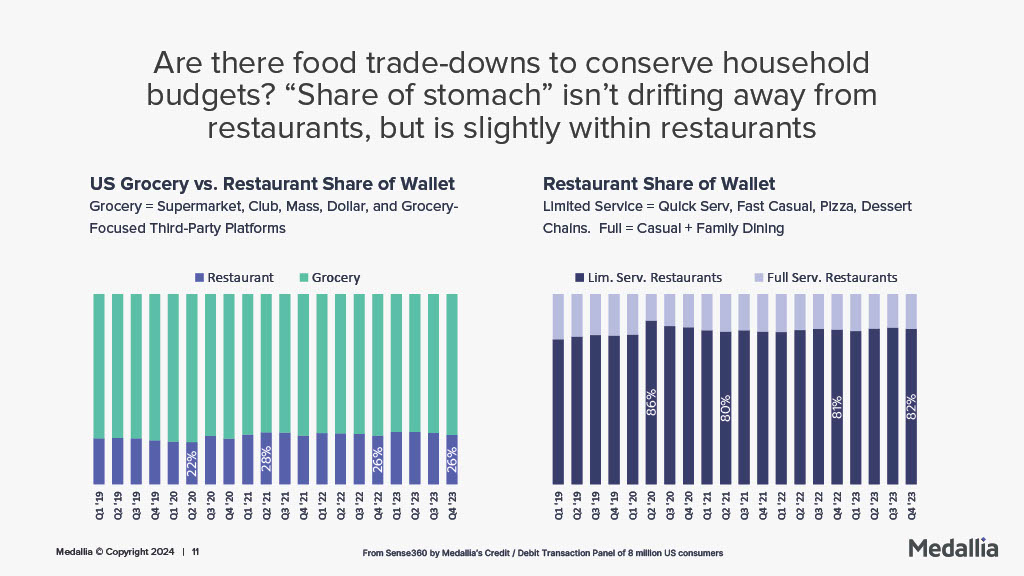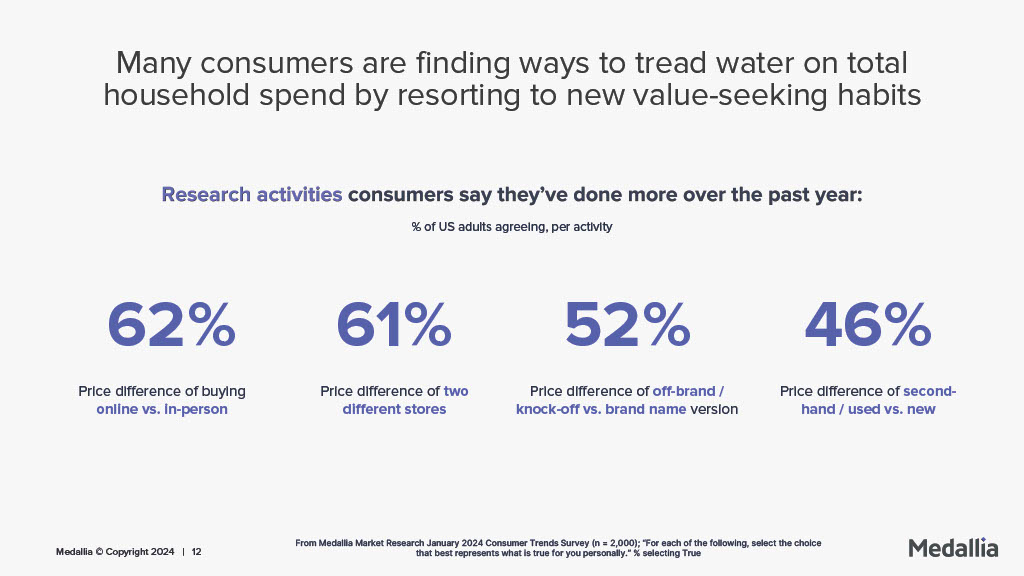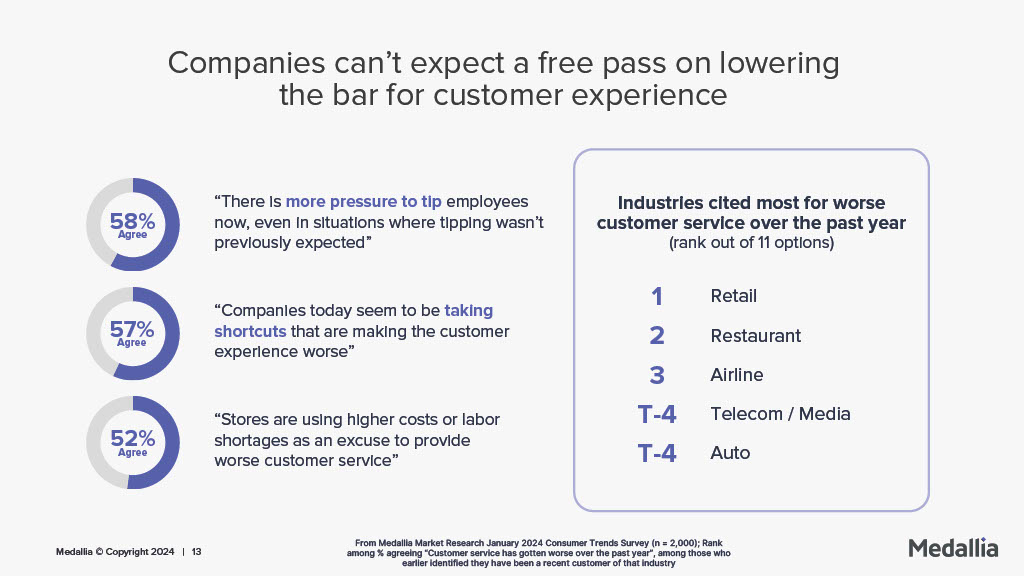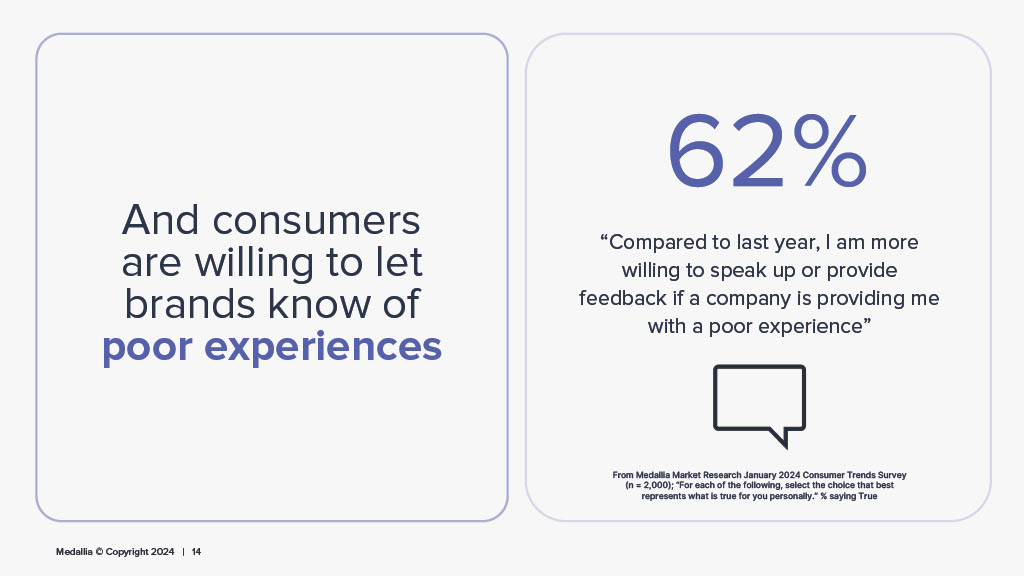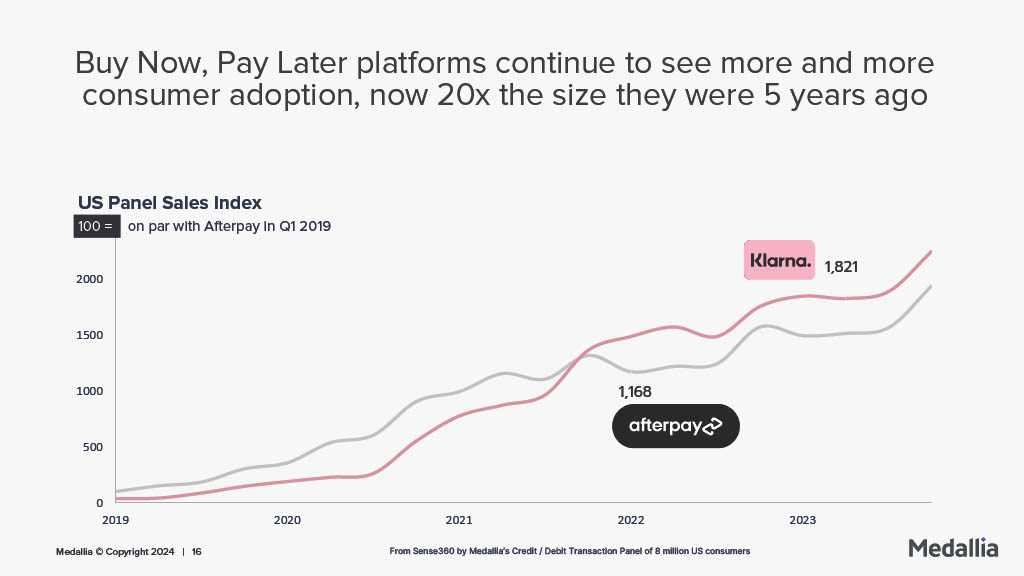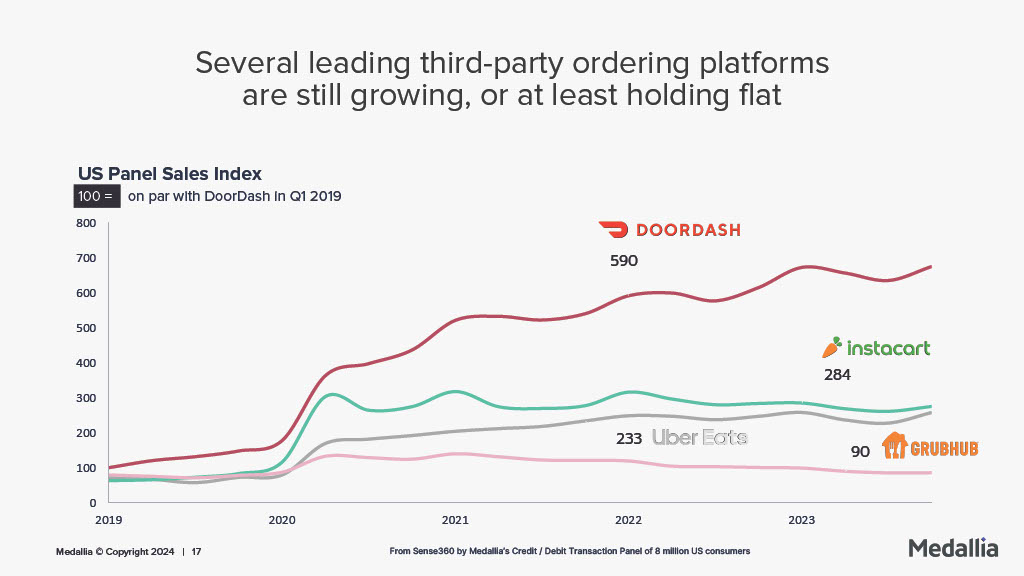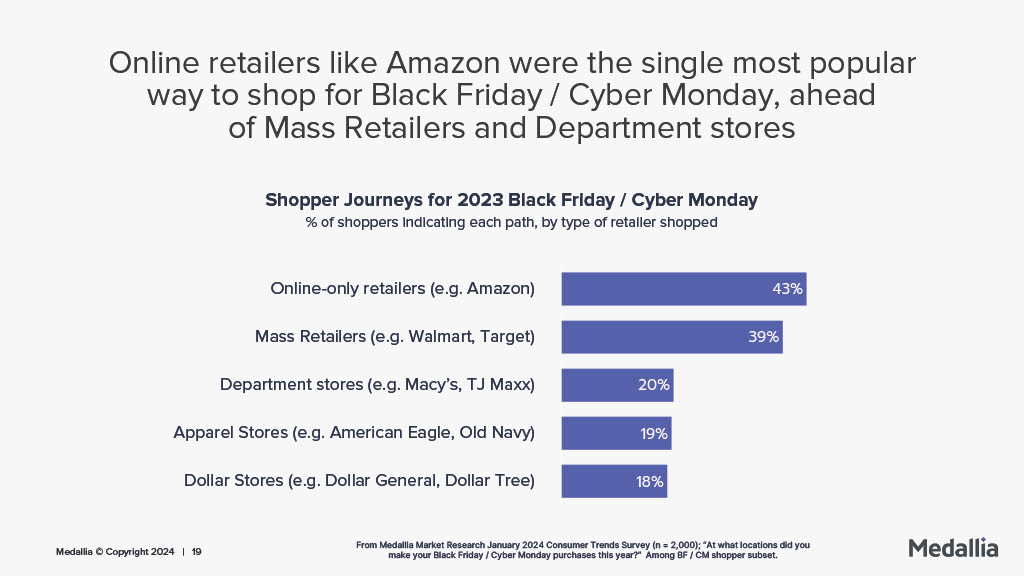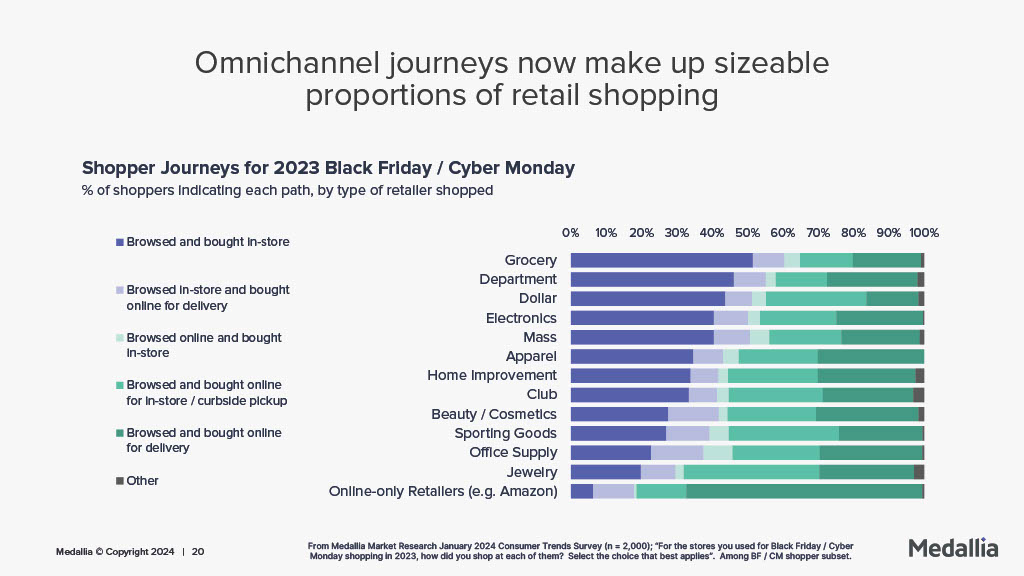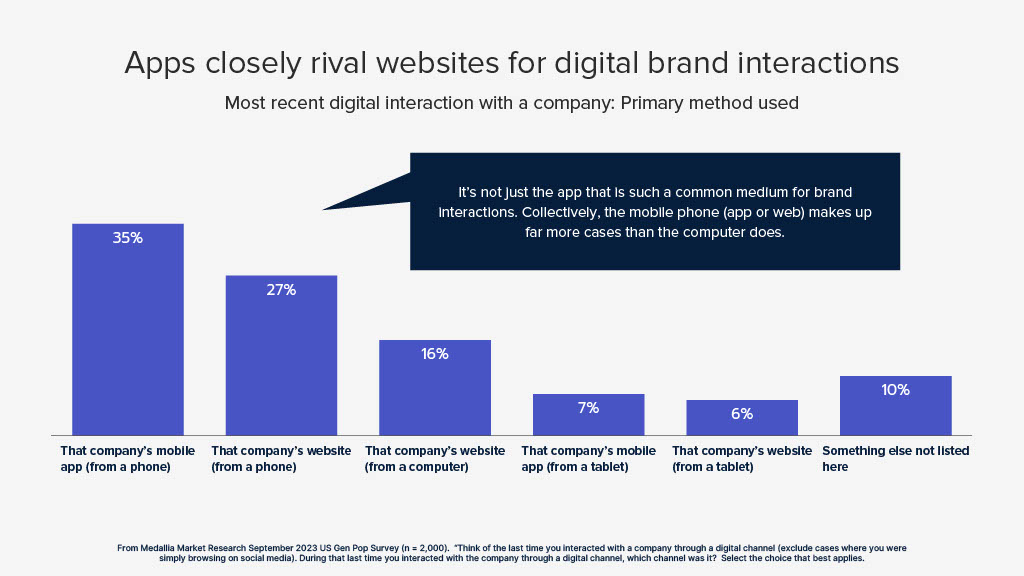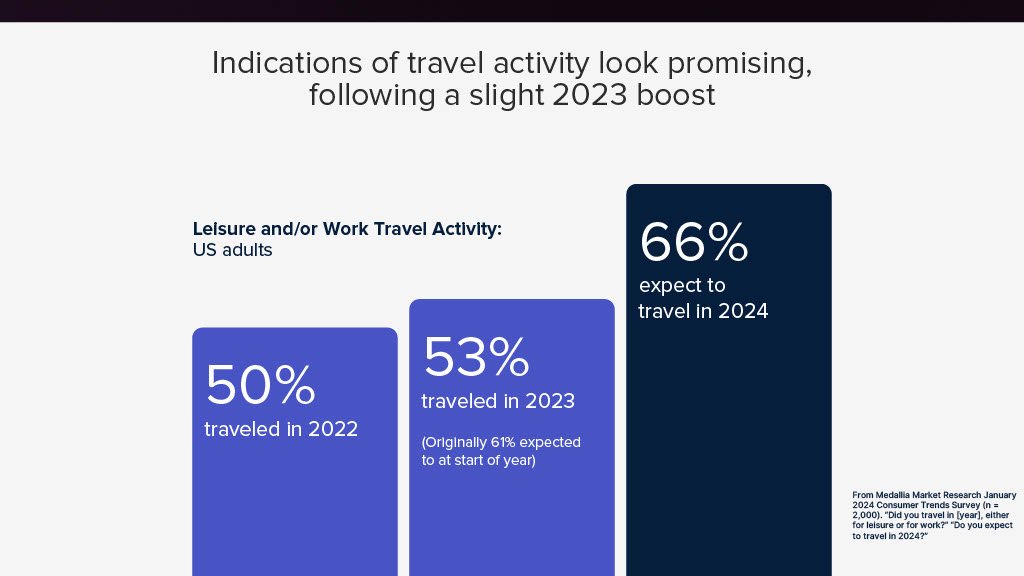Top 18 Consumer Trends Impacting Customer Experience in 2024
April 26, 2024
Market Research
The top consumer trends impacting customer experience in 2024 are being shaped by inflation, digital channels, and evolving lifestyles.
What are the latest consumer trends that brands need to know about in 2024? For answers, Medallia Market Research conducted a survey of 2,000 consumers and an analysis of the credit and debit transactions of 8 million U.S. consumers to find out what changes we can expect to see across customer spending and savings, dining, ordering, travel, shopper journeys, product discovery, content streaming, and more in the year ahead.
Medallia’s Head of Market Research Insights, Andrew Custage, revealed the latest findings from this study in a report: Consumer Trends Research: What to Know for 2024. He shared that this year consumer behavior is being shaped by three major forces: macroeconomic influences like inflation, technology — including generative AI and digital channels — and evolving lifestyles.
In this article we’ll share the highlights of this presentation, including the top 18 consumer trends impacting customer experience we’re seeing unfold in 2024 and what brands can do to adapt in line with changing consumer behavior, interests, and preferences.
Top 18 Consumer Trends in 2024
1. For the fourth year in a row, price is the number #1 factor driving household purchase decisions, but fewer consumers are citing cost as their top concern compared to in 2022 and 2023.
In 2021, “change in prices” was a top influence shaping purchasing behavior for roughly one-third of adults in 2021.
“By the time we got to mid 2022 and early 2023, though, this number had jumped up dramatically, and this was in the face of the heaviest periods of inflation,” explains Custage. “What we have seen over the past year, though, is that this number has receded back down to near where it was in 2021. It still is the top-ranked factor individually, but it’s shrunk as far as how often it’s cited, and it’s now once again at around a third of households that are selecting it as one of the choices.”
The uptick in 2022 to 2023 and now downtrend in 2024 follows the rise and fall of the rate of inflation rate itself. The main takeaway for brands: Inflation and high prices are still important for consumers, but not as influential as they used to be.
2. As consumers have adjusted to inflation, consumer transaction volume is down slightly, while spend per transaction has remained steady.
What we’re seeing unfold is a mix of prices settling down, paired with shoppers either slightly easing up on the number of items purchased per transaction or trading down and purchasing cheaper alternatives in place of the products they’d normally buy.
3. Some consumers may be racking up debt to get by, but it might not be a growing problem.
The majority of consumers (66%) say they’re finding ways to cut back on non-essential spend. Meanwhile 41% say they’ve increased their income to compensate, such as by landing a new job or promotion or taking on extra hours.
Roughly one-third of consumers are in the position of having to save less or take on more debt to compensate for rising costs. Though this behavior isn’t sustainable, Custage doesn’t see this trend ultimately affecting economic growth for three key reasons:
- The proportion of respondents who say they’re dipping into their savings or adding on more debt isn’t growing — this percent has remained relatively steady for the past two years.
- Retail activity remains fairly unchanged, as illustrated in trend #2 above. In other words, there haven’t been the kinds of cutbacks in spending that are drastic enough to lead to a recession.
- When we surveyed consumers this year about their debt over the past 12 months and whether it’s grown or declined, the percent of consumers who say they have more debt than they used to is roughly equal to the percent who say they have less debt.
4. As inflation persists, consumers are adjusting their purchases and focusing on essentials vs. nice-to-haves.
The biggest differences consumers cited between their spending in 2022 and 2023 were that they made lifestyle changes to reduce their purchases and that they learned to accept higher prices and plan financially based on these expenses.
“Consumers have just gotten used to what the new normal is and their behavior has adjusted accordingly and, to some extent, permanently,” says Custage.
As part of this trend toward adjusting spending, consumers appear to be favoring retailers that offer need-to-have items, he adds.
The winners are ecommerce platforms, grocery stores, dollar stores, and club retailers, and the ones that are trending downwards fall into categories like leisure, home improvement, and fitness.
5. Despite cost concerns, consumers aren’t cutting back on dining out.
Spending on food is one of the biggest expenses for individuals, and, with rising inflation, many thought consumers would cut back on dining out as a “nice to have” as well and instead shift to spending on groceries.
“We really haven’t seen that trend play out, and a lot of it can be due to the built-in convenience and time savings of restaurants that turn many consumers away from groceries regardless of what prices are,” Custage explains, adding that the rate of inflation was also higher for groceries in 2022 to 2023 compared to restaurant food. “And that helped at least restaurants win the sticker shock concerns that consumers would experience when seeing how much grocery prices had gone up and just turn them away from that and towards restaurants, even if the cost per meal is still higher at a restaurant.”
As a result, the balance of the share of wallet between grocery stores and restaurants hasn’t changed much due to inflation. And the rate of switching from dining at costlier full-service restaurants to dining out at more budget-friendly fast casual establishments has been modest.
“There’s been a little bit of a trade-down effect where more often if people are buying restaurant food, they’re going to turn to quick service and fast casual instead of casual dining or family dining or sit-down dining, where it’s a little more expensive per meal,” he says.
In response, restaurants have rolled out some pretty creative strategies, such as Applebee’s launching a subscription model offering guests greater savings per visit.
6. Today’s shopper is conducting more research before making a purchase.
To adapt to inflation, consumers are more likely to price compare the cost of buying the same product at different stores, the same product online vs. in person, an off-brand item vs. the brand-name version, and an item second hand vs. new.
“As consumers are becoming a little bit savvier, I think a big takeaway for restaurants, retailers, hospitality, and anybody else in the space is to be more aware of the shopper journey and what’s visible to consumers in terms of price, being cognizant of whether you’re competing on price to begin with or if you’re competing on another attribute like experience, value, service speed, or product quality,” says Custage.
For brands that are losing out on price, they need to make sure they’re differentiated in another way to win over increasingly savvy and discerning consumers.
7. Generative AI is becoming part of the shopper journey.
More than one-third of Millennials and Gen Zers say they’ve used artificial intelligence for ideas about what to buy or where to shop.
While there may not be much that retailers can do right now to try and improve their standings within the results AI tools produce, this new consumer trend is important to be aware of, one that will undoubtedly grow over time, explains Custage. It’s also worth noting that there’s some level of consumer comfort with engaging with AI to assist with shopping and retail decision-making, a trend that brands could ultimately use to adapt their strategies and offerings on their owned channels.
8. Consumers are noticing the increased pressure to tip — even in situations where tipping wasn’t previously expected — and the cuts companies are making that are having a negative impact on the customer experience.
Most consumers observe that there’s a greater pressure to tip these days and that there have been changes for the worse to the customer experience and customer service companies offer as a result of cutbacks, with retailers, restaurants, and airlines cited as the worst customer service offenders in 2024.
9. Consumers say they’re more likely to speak out about negative customer experiences.
More than three in five consumers (62%) say that they’re more willing to speak up when a company provides them with a poor experience in 2024.
In response, brands should collect customer feedback through internal channels to learn from these insights and adapt their strategies accordingly. Companies that aren’t proactive run the risk of customers sharing their poor experiences on public forums, which could impact their overall brand reputation and turn potential customers away.
10. Buy-now, pay-later’s growth continues to soar — not just as a payment option, but in shaping the entire customer journey.
These payment platforms, which have grown by 20X over the last five years, influence the brands that customers decide to shop with and where they make purchases, based on the availability of third-party buy-now, pay-later partners, says Custage. For many, the shopping process starts with seeing where their preferred payment option is accepted or whether platforms like Klarna or Afterpay are offering promotions or deals.
11. Third-party ordering platforms have become a permanent part of the digital retail and restaurant customer journey.
Collectively, the industry is stable and experiencing all-time highs in terms of sales, even as the initial drivers of third-party ordering platforms’ success — stay-at-home orders and social distancing guidelines — are no longer factors.
“Even in the face of rising costs and the issues that consumers have with tipping or added service fees or price increases on one channel versus another, the built-in convenience and habit forming that platforms like DoorDash and Instacart have been able to achieve over the past few years, beginning at the height of COVID-19 and really continuing not giving up much ground at all, has shown that these platforms are really here to stay,” Custage explains.
One factor fueling the success of these platforms? The rise of Gen Z, many of whom are members of the workforce, live on their own, and have only been consumers with purchasing power in an era in which these platforms existed.
The goal for restaurants and retailers should be to have a clearly defined customer experience strategy for their presence on third-party ordering platforms, to use these platforms strategically as an acquisition tool, and, ultimately, to encourage customers to migrate over to direct, first-party ordering.
12. Amazon just keeps on growing.
The online retailer is now the go-to for consumers for tentpole shopping events like Black Friday and Cyber Monday, ahead of traditional mass retailers and department stores.
The company has built momentum with their own retail holiday, Prime Day, a bandwagon other brands are attempting to hop on by rolling out their own competing retail holidays to win back some share of wallet.
13. Omnichannel journeys are the new normal.
While about half of consumers continue to browse and buy groceries in person (a single-channel experience) and online-only retailers are dominated by digital-only journeys, most other kinds of retailers — from department stores and dollar stores to office supply stores and jewelry stores — have a much more nuanced, omnichannel customer journey, with a mix of behaviors that include browsing in store and buying online for delivery, browsing online and buying in store, and browsing and buying online for curbside pickup.
There’s a clear call to action for retailers: These experiences and touchpoints must no longer be managed in silos.
“There’s really a need for this more cohesive view of the customer and having a continuity of knowledge of the activity customers have from one channel to the next…considering how often consumers are starting in one channel and then are jumping across to another,” explains Custage.
14. Brands’ mobile apps are the most popular digital touchpoint for customers.
Consumers are most likely to interact with brands digitally via a mobile device, either via the company’s mobile app (35%) or company’s website via a phone (27%).
For businesses, that means enhancing the app and mobile experience need to be a top priority to drive repeat engagement, conversions, upsells, and crossales, says Custage.
15. Social media is playing a bigger role in the product discovery journey than it did a year ago.
More than half of consumers agree that social media is having a bigger influence on how they find out about products in 2024 than in 2023, with Facebook, Instagram, and TikTok being the top sources of product information.
Brands should pay attention to differences in product discovery by generation, and, as Gen Z becomes a more powerful consumer group, it will be important to keep an eye on the channels younger audiences use to learn about and engage with brands.
16. Not surprisingly, Baby Boomers are more likely to watch live TV, while younger generations are more likely to consume user-generated content on streaming services and play video games.
“Gen Zers are engaging with media much differently than their older counterparts,” explains Custage.
As such, for brands looking to reach younger consumers, they’ll need to become proficient in creating short-form user-generated content with influencers, he adds.
17. Consumers are streaming more content in 2024 than they did 12 months ago.
Both streaming video and audio content are gaining traction, with consumers reporting an uptick in each by 12% and 6%, respectively.
18. Consumer optimism about travel is at a three-year high.
Even in the face of inflation, travel continues to grow as we get back to normal after the temporary declines the industry experienced related to COVID-19.
For 2024, the most popular types of travel include heading to the beach, visiting friends and family, and exploring cities.
Prepare for Future Consumer Trends in 2024 and Beyond
Find out how Medallia Market Research can help your company stay ahead of changing market dynamics and the latest and emerging trends in consumer behavior, customer experience, and digital experience so you can take action with confidence to capture more market share.

